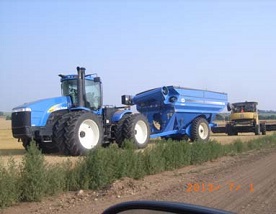WisDOT has a responsibility to maintain and preserve a safe network of bridges and roads. Axle weights and spacing have a significant effect on the long term condition of our bridges and roadways. Overweight vehicles present the risk of accelerated bridge deterioration and pavement damage. Decreasing axle weights and increasing axle spacing can help reduce these risks.
Structures and pavements
Wisconsin has a known inventory of over 14,000 bridges, which are maintained by state and local agencies. Design loads for bridges are determined at a national level. Over time, the size and weight of vehicles traveling over bridges has grown immensely, while the load capacity for which the bridge was designed has remained static.

Additionally, every time a vehicle passes over a pavement a portion of its life is consumed. Pavement engineers design roadways based on the amount, type and weight of the traffic using the road over a given period of time. Additional factors that affect pavement capacity include
frozen roads and
spring thaw, which weaken pavements.
Images of common pavement damage are shown below. Cracking in wheel paths (left) contributes to rapid deterioration of the pavement structure. Rutting (right) is a safety concern as it can lead to dangerous hydroplaning.

